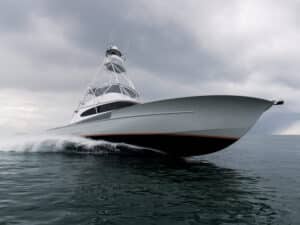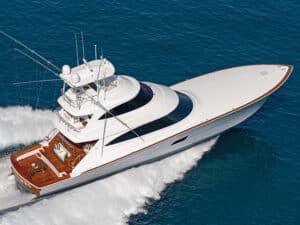
Cabo 48 Flybridge salon_03
Ask the opinion of anyone who fishes offshore and they’ll undoubtedly tell you that Cabo makes a “really nice boat.” Its interiors always show an understated elegance, and the fishing amenities include everything you’d put aboard if you had selected each item personally. All Cabos exhibit exquisite lines, and I defy anyone to point out a better-engineered engine compartment than the ones you’ll find in a Cabo. They also boast a better-than-average ability to raise fish and win tournaments.
With all these things going for it, you’d think that Cabo might just sit back and subscribe to the “if-it-ain’t-broken-don’t-fix-it” philosophy. But that wouldn’t fit the personality of the company or its founders. Henry Morschladt and Michael Howarth incorporate improvements into every new hull they introduce.
Sharper entries may take a little space out of the forward cabin, but they also provide a smoother and drier ride in a head sea. And, while the old running gear pushed the boat along quite nicely, new gear just might improve the boat’s handling. The list goes on and on.
Performance
Running out Miami’s Government Cut in a nasty 6-foot, wind-against-tide head sea qualifies as a good test of an offshore boat’s capabilities. We plowed our way through the churning waters at the mouth of the inlet at a steady 23 knots until we cleared the jetties, then pushed it up to a comfortable 33-knot cruise as we moved northward up the beach in a 4-foot beam sea.
Surprisingly, this 48 Flybridge, with its high center of gravity, rolled no differently than the Cabo 40 Express we ran earlier in the day. Yes, it rolls a fair distance in a beam sea, but with gentle transitions – no snap rolls.
The 48 also provides the quintessential two clear alleys of blue water to run your baits, and most turbulence disappears within about 50 feet of the transom. Our boat sported a pair of optional MAN D2876LE 403s, each producing 1,050 hp. You can also choose800-hp MANs for standard power or middle-of-the-road 1,015-hpCATs.
In the calmer water by the cruise-ship docks, my GPS clocked the48 at 37.1 knots turning 2,375 rpm. And the big MANs move the 48 at about 6 knots, even with just one engine in gear. Obviously, transiting a harbor will require bumping it in and out of gear – or the installation of aftermarket electronic controls that provide low-idle or trolling valves.
The Cabo’s hydraulic steering reacts instantly to any wheel action, though a hard-over turn at cruising speed starts quickly, then settles into a more conservative course change.
Fishability
You’ll find plenty of room for multiple anglers and crew to work this 48’s cockpit. The padded coaming hit me about mid-thigh, and though it was a bit of a stretch to bill a sailfish, remove the hook and release it, the mate pulled it off. People with short arms may want someone to hold their belt.
Other fishing features include large insulated fish boxes with macerators and a large transom door with a top gate. For those who back down hard, all the hatches for the lazarette and fish boxes sport heavy-duty O-ring seals to keep your fish iced and the bilges dry.
Oh, and don’t be fooled by the perception that the two rod holders in each gunwale and a few across the back of the flybridge represent the sum total of rod storage aboard the Cabo. It offers more hidden rod storage than you can imagine filling.
Flybridge
The tournament-style configuration assures the helmsman a clear view of most of the fighting chair and the aft two-thirds of the cockpit. Additionally, I found a remarkably unobstructed view forward. Standard equipment includes a varnished teak, Palm Beach-style helm pod with single-lever controls.
The MAN engine displays provide most of the pertinent information, but I still don’t understand why the company won’t allow you to view fuel flow in gallons per hour rather than only liters per hour.
Notwithstanding, the large molded electronics console provides more than enough room for all your electronics plus additional units for redundancy. A bench seat forward of the console offers loads of storage space, as do the forward storage lockers and the helm storage cabinet. My favorite aspect of our test boat had to be the number and locations of handholds on the bridge and throughout the entire boat. Handholds constitute a major offshore safety feature and should never be over looked.
Engine Room
As I said earlier, I defy anyone to find a better-engineered engine compartment than those on a Cabo, and this 48 is no exception. Cabo labels every wire, includes chafe protection wherever the wire passes through a vertical surface, and runs all the piping in a neat and orderly fashion. All standard-maintenance items can be found near at hand on centerline, including an emergency, engine-driven bilge-pump valve at the base of the ladder up to the cockpit.
Use of common sense dictates that everything that makes noise -like compressors and generators – gets placed in the engine compartment’s aft end. Cabo mounts all the quiet equipment on the forward end near the living quarters.
Cabo doesn’t skimp on safety, either: Braided metal, fire-retardant fuel lines, double stainless-steel hose clamps, grounding and bonding system, bronze seacocks on all thru-hulls, and dripless stuffing boxes all might cost more, but it pays to have things done right. Other nods to safety include the backup cables on the electronic controls, ensuring that if the main controls go down, you can still stop and start the boat.
Cockpit
Because so many Cabo owners love their boats but don’t necessarily fish, many of the fishing amenities come as options. But you can readily set up your boat for serious offshore fishing by simply checking a box on the order form. Everything you could possibly want is available from the factory. For example, you can get freezer plates in the cockpit icebox and the fish boxes or plumb the portside fish box for an Eskimo ice machine. Both large insulated fish boxes come equipped with macerator pump-out systems.
The deck comes standard with a glassed-in backing plate for a fighting chair, and adding four rocket launchers on the bridge rail brings the total number of rod holders around the cockpit to nine. The bait-prep center to port – fitted with custom lid, gas spring actuator and a full-length stainless-steel piano hinge with custom latch – features a sink, rigging board and loads of tackle storage.
Our test boat had a 48-gallon live well molded into the transom. However, I much prefer the beautiful see-through Lucite insert option Cabo offers. At night with the livewell lights on, the cockpit turns into your own private aquarium. If you’re the type who backs down hard and abuses your hatches, Cabo keeps you out of trouble with heavy-duty gaskets and piano hinges on each lid. Let a Cabo hatch slam and all you hear is a whoosh as the air escapes.
Interior
From a distance, there’s no mistaking that this boat is a Cabo through and through. Further investigation shows a hull molded with high-quality, ISO/NPG gel coats and vinyl ester resins throughout for maximum protection against sun, salt and osmotic blistering. Laminate strength also stems from a solid fiberglass bottom and vacuum-bagged Core-cell foam in the topsides, along with stitched biaxial fiberglass. Every piece of fiberglass inside a Cabo (even those you can’t see) gets finished with white polyester gel coat for an easy-to-clean surface.
Perhaps the most attractive aspect of a Cabo interior is its lack of ostentation. Cabo uses the finest leathers, fabrics and lighting fixtures, but keeps the ambience muted rather than flaunting the decor until it reminds one of a bordello. I’ve never found a person with good taste who didn’t immediately fall in love with a Cabo interior. They’re rich without flash.
Cabo offers few options for the interior. Pick carpeting or a teak-and-holly sole for flooring. Choose the color of your countertops and between leather or fabric for the upholstery. What color custom sheets would you like for your cabins? The salon boasts deep-pile carpeting, a central vacuum cleaner system, powerful custom entertainment center and Cabo’s gorgeous signature teak joiner work with satin-finish varnish. The galley, on the same level, allows you to seriously prepare meals at sea, thanks to sea rails on the Corian counters, positive latches on all the drawers and cabinets, and four Sub Zero drawers below the counter (two refrigerator, two freezer). Of course, all the other galley appointments you’d expect to find in a fine home are also included.
Below decks, the forward cabin sports a double berth offset to port, an overhead hatch, two hanging lockers, loads of storage, terrific lighting, and rod storage lockers up under the foredeck. You even get a wall safe as standard fare. The guest cabin offers a one-double- and one-single-berth layout with a single hanging locker. It also shares a head with the forward guest stateroom. Both guest and master heads feature Corian counters and separate stand-up shower stalls. It’s always a good omen when a boatbuilder offers a fairly limited options list. That means that a lot of thought has gone into building a complete boat, freeing the owner from anguishing over little details. It has worked well for Lexus, and it continues to work well for Cabo.
Specifications
LOA 50’7″
BEAM 15’8″
DRAFT 4’0″
WEIGHT 45,000 pounds
DEADRISE 11.5 degrees
FUEL 900 gallons
WATER 100 gallons
POWER T1,050-hp diesel
BASE PRICE $946,340 (w/T800-hp diesels)
Cabo Yachts
760-246-8917
www.caboyachts.com







